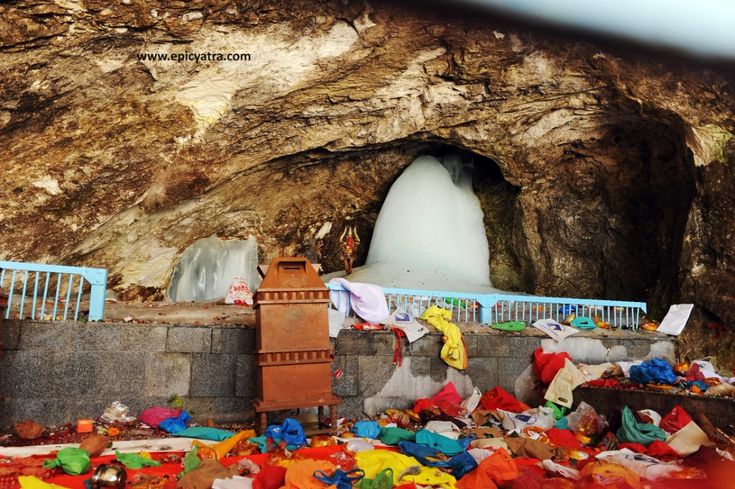The Amarnath Yatra is one of India’s most revered pilgrimages, drawing devotees from across the country and around the world. This sacred journey to the Amarnath Cave, nestled in the breathtaking Himalayas of Kashmir, offers both spiritual fulfillment and an incredible adventure. In this guide, we’ll explore everything you need to know about this remarkable pilgrimage.
What is the Amarnath Yatra?

The Amarnath Yatra is an annual pilgrimage to the Amarnath Cave, which houses a naturally formed ice lingam (a symbol of Lord Shiva). This ice formation is believed to grow and shrink with the phases of the moon, reaching its peak during the summer months when the pilgrimage takes place. Devotees consider this a manifestation of Lord Shiva himself, making the cave one of the holiest shrines in Hinduism.
The Sacred Legend

According to Hindu mythology, it was in this cave that Lord Shiva explained the secret of immortality and the creation of the universe to his divine consort, Parvati. The cave is said to be the same place where Shiva removed his divine adornments and became one with everything around him. When a pair of doves overheard this sacred knowledge, they became immortal and are believed to still reside in the cave.
Location and Geography
The Amarnath Cave is situated at an altitude of approximately 3,888 meters (12,756 feet) in the Lidder Valley of South Kashmir. It’s nestled among the stunning peaks of the Himalayas, surrounded by glaciers and snow-capped mountains. The journey to reach this remote location is itself a test of devotion and endurance.
When Does the Yatra Take Place?
The pilgrimage typically occurs during the Hindu month of Shravan (July-August), lasting for about 45-60 days. The exact dates vary each year based on the Hindu lunar calendar. During this period, the ice lingam is at its largest size, making it the most auspicious time for the pilgrimage.
Routes to Amarnath Cave
There are two main routes to reach the holy cave:
1. Pahalgam Route (Traditional Route)
- Distance: Approximately 46 kilometers from Pahalgam
- Duration: 3-5 days one way
- Starting Point: Pahalgam, also known as the “Valley of Shepherds”
- Path: Chandanwari → Sheshnag → Panchtarni → Holy Cave
- Difficulty Level: Moderate to difficult
This traditional route is longer but offers stunning landscapes and a more gradual ascent, making it easier for those not accustomed to high altitudes. The journey is broken into stages, with overnight stays at designated camps.
2. Baltal Route (Shorter Route)
- Distance: Approximately 14 kilometers from Baltal
- Duration: 1 day one way (can be completed in a single day)
- Starting Point: Baltal, a small village near Sonamarg
- Difficulty Level: Steep and challenging
The Baltal route is shorter but steeper, making it more physically demanding. However, it allows pilgrims with limited time to complete the journey in a single day. Many choose to hire ponies or palanquins (dandis) to assist with this route.
Registration and Permits
Every pilgrim must register with the Shri Amarnathji Shrine Board (SASB) before undertaking the journey. This registration process includes:
- Obtaining a Yatra Permit (Yatra Parchi)
- Medical fitness certificate
- Age restrictions (typically between 13-75 years)
- Personal identification
Registration can be done online through the official SASB website or at designated bank branches across India. The authorities issue a limited number of permits each day to manage the flow of pilgrims and ensure safety.
Essential Preparations
Physical Fitness
The Amarnath Yatra involves trekking through challenging terrain at high altitudes. Pilgrims should:
- Begin cardio exercises at least 3 months before the yatra
- Practice walking on inclines
- Focus on building leg strength and stamina
- Gradually increase their endurance with longer walks
Health Precautions
- Get a thorough medical checkup before the journey
- Carry all necessary medications, especially for existing conditions
- Consider altitude sickness prevention medications like Diamox
- Bring a basic first-aid kit
Clothing and Gear
- Warm, waterproof clothing (even in summer, temperatures can drop significantly)
- Sturdy, broken-in hiking boots with good grip
- Rain protection (jacket and cover for backpack)
- Thermal innerwear
- Gloves, woolen socks, and headgear
- Sunglasses and sunscreen (high-altitude sun exposure is intense)
- Walking stick or trekking pole
Essential Items
- Valid ID proof and Yatra Permit
- Torch with extra batteries
- Water bottle and water purification tablets
- Energy bars and dry fruits for quick energy
- Basic toiletries
- Small towel and biodegradable soap
- Portable oxygen can (available at medical shops)
Facilities Along the Route
The Shri Amarnathji Shrine Board and local authorities provide various facilities along both routes:
Accommodation
- Tent accommodations at designated camps
- Basic shelters at stopping points
- Prepaid tent bookings available through SASB
Food Services
- Langar (community kitchens) offering free meals
- Small eateries and food stalls
- Tea stalls at regular intervals
Medical Facilities
- Medical aid centers at all major camps
- Emergency helicopter services for evacuation
- Oxygen facilities at high-altitude points
Communication
- Limited mobile network coverage
- Emergency satellite phones at major camps
Weather Conditions
The weather in the Himalayan region is unpredictable, with conditions changing rapidly. Pilgrims should be prepared for:
- Sudden rainfall
- Cold temperatures, especially at night
- Occasional snowfall even during summer months
- Strong winds at higher altitudes
It’s crucial to check weather forecasts regularly and follow instructions from authorities regarding path closures or delays due to adverse weather.
Cultural and Spiritual Aspects
The Amarnath Yatra is not just a physical journey but a deeply spiritual experience. Along the way, pilgrims often:
- Chant “Har Har Mahadev” and other hymns dedicated to Lord Shiva
- Observe fasting or follow a sattvic diet (pure vegetarian)
- Practice abstinence and simplicity
- Engage in meditation and prayer
- Participate in group bhajans (devotional songs) at the camps
Ethical and Environmental Considerations
As responsible pilgrims, it’s important to:
- Carry back all plastic and non-biodegradable waste
- Use designated toilets and washing areas
- Respect local customs and traditions
- Avoid disturbing the natural environment
- Follow the “Leave No Trace” principle
The Shrine Board has implemented strict waste management protocols in recent years to preserve the pristine environment of the region.
Safety Measures
Safety is a top priority during the Amarnath Yatra. The government deploys:
- Security personnel along the entire route
- Medical teams at regular intervals
- Rescue teams for emergencies
- Weather monitoring systems
- Communication networks for updates and alerts
Pilgrims are advised to:
- Always stay on the designated path
- Move in groups rather than alone
- Keep emergency contact numbers handy
- Inform camp authorities before departing for the next stage
- Carry identification at all times
Cost Considerations
The cost of the Amarnath Yatra varies depending on your choices:
Budget Options
- Registration fee: Approximately ₹100-200
- Staying at free camps or langars
- Using community kitchens for meals
- Taking public transport to base camps
Moderate Options
- Hiring ponies: ₹2,000-4,000 (depending on route and distance)
- Staying in prepaid tents: ₹500-1,500 per night
- Hiring porters for luggage: ₹1,000-2,000
- Eating at local eateries: ₹100-300 per meal
Premium Options
- Helicopter services: ₹3,000-5,000 per person (one way)
- Palanquin (dandi) services: ₹10,000-15,000
- Guided tours with premium accommodations: ₹20,000-30,000
Special Considerations for First-Time Pilgrims
If you’re undertaking the Amarnath Yatra for the first time:
- Consider joining an organized group
- Opt for the Pahalgam route for better acclimatization
- Schedule an extra day at base camps before ascending
- Start physical preparation well in advance
- Connect with experienced pilgrims for advice
The Darshan Experience
The culmination of the journey is the darshan (viewing) of the ice lingam in the Amarnath Cave. Upon reaching the cave:
- Pilgrims typically queue for their turn
- The cave is surprisingly small, with the ice formation visible from the entrance
- Photography is restricted inside the cave
- Priests perform rituals and offer prasad (blessed food)
- Each pilgrim gets a brief moment for prayers and offerings
The ice lingam is surrounded by two smaller ice formations, believed to represent Goddess Parvati and Lord Ganesha.
Beyond the Pilgrimage: Extending Your Journey
Many pilgrims combine their Amarnath Yatra with visits to other nearby destinations:
- Pahalgam: Enjoy the pristine beauty of this hill station
- Sonamarg: Known as the “Meadow of Gold” for its stunning landscapes
- Srinagar: Explore the famous Dal Lake and Mughal Gardens
- Gulmarg: Visit this popular hill station known for its meadows and ski resort
- Vaishno Devi Temple: Another important pilgrimage site in Jammu
Testimonials from Pilgrims
Pilgrims often describe the Amarnath Yatra as a life-changing experience. Many report:
- A profound sense of peace and spiritual fulfillment
- Renewed strength and determination
- Appreciation for the simplicity of life
- A deeper connection with nature
- Lasting bonds formed with fellow pilgrims
Digital Resources
For up-to-date information and assistance:
- Official SASB website for registration and updates
- Amarnath Yatra mobile app for real-time information
- Weather forecasting services specific to the region
- Online forums where experienced pilgrims share advice
Conclusion
The Amarnath Yatra is much more than a religious pilgrimage—it’s a journey that tests physical endurance, mental strength, and spiritual dedication. Despite the challenges, thousands of devotees undertake this sacred trek each year, drawn by faith and the promise of divine blessings.
Whether you’re a devout Hindu or someone interested in exploring India’s rich spiritual traditions, the Amarnath Yatra offers a unique blend of adventure, culture, and spiritual growth. With proper preparation and respect for the traditions, this journey can be one of the most rewarding experiences of your life.
Remember that the true essence of the yatra lies not just in reaching the destination but in embracing the journey itself—with all its challenges, moments of beauty, and opportunities for inner reflection. As the ancient saying goes, “The journey is the destination.”




